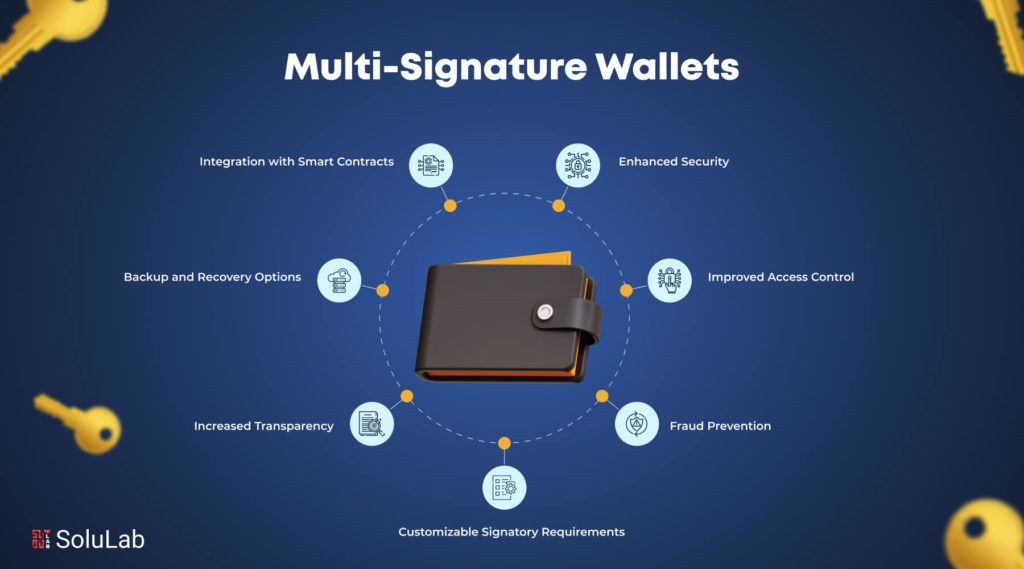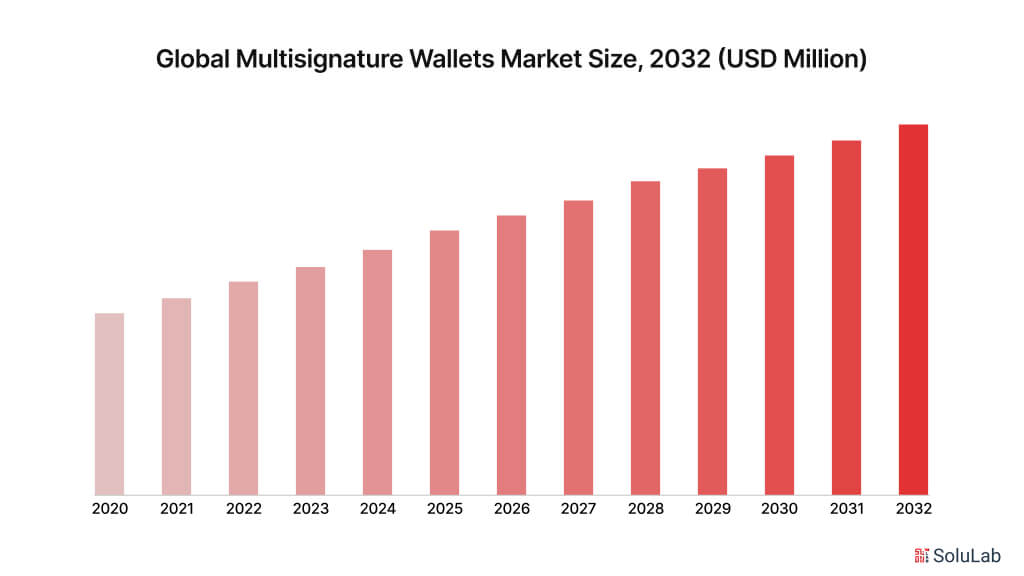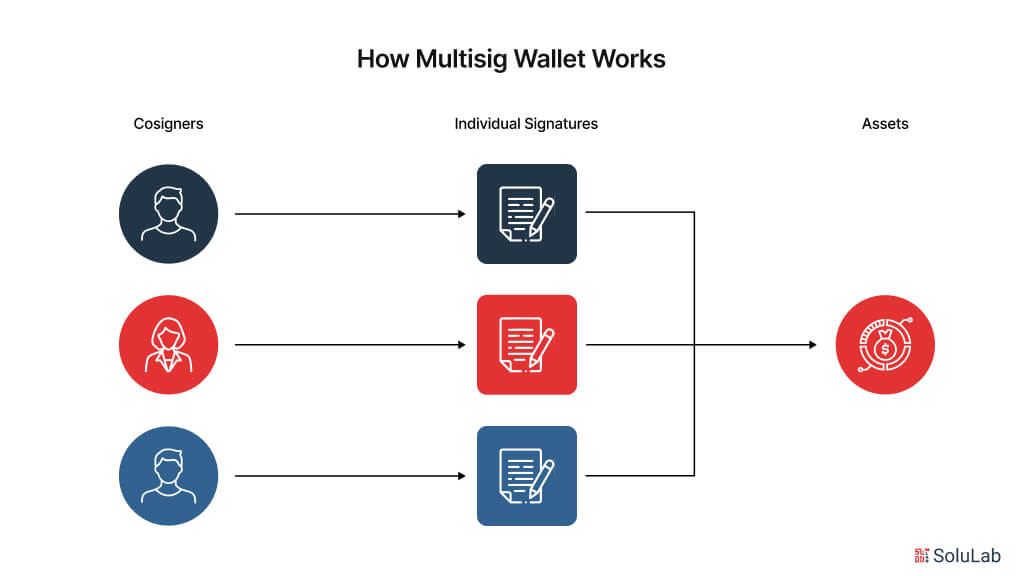
The widespread adoption of web3 is being facilitated by smart contract wallets, which are opening up powerful new capabilities that greatly improve the web3 wallet experience for both new and returning users. Nowadays, it’s no secret that using a wallet is a horrible experience. The majority of classic web3 wallets, such as MetaMask, Coinbase Wallet, and Rainbow Wallet, are hazardous and challenging to use.
However since Ethereum introduced ERC-4337, or account abstraction, which makes “smart accounts” feasible, many more are choosing to give their consumers better wallet experiences by using different kinds of smart contract wallets for different use cases. Among those web3 wallet kinds that are becoming increasingly well-liked are multi-sig (also known as multi-signature) wallets. The multi-signature wallet market has seen a growth rate of 25% annually, driven by increasing awareness and demand for improved security measures.
One of the biggest concerns in the subject of cryptocurrencies has always been security, and multi-signature wallets are becoming more and more popular due to their dependability. Since many private keys are required for transactions in these wallets, theft, and unwanted access are more difficult. Making use of the best multi-signature wallets is the most effective option if you want to increase the control and security of your cryptocurrency transactions. Everything you want to set up and maintain your own wallet, as well as comprehend the fundamentals, will be covered in this comprehensive guide on multi-signature wallets.
What is a Multi-Signature Wallet?
Wallets for cryptocurrencies that have extra security settings and require two or more signatures to approve an outgoing transaction are known as multi-signature wallets. These wallets, also known as “multi-sig,” are especially helpful when numerous people possess cryptocurrencies or other digital assets that are being kept in custody by an organization.
Unlike regular cryptocurrency wallets that simply require one signature, these wallets need more technical know-how to set up and operate. For individuals with complicated security requirements, however, the increased security benefits outweigh the higher technological requirements.
Although digital wallets and cryptocurrencies have numerous benefits and security features, there are numerous tales about assets being stolen and cryptocurrency coins being lost when only one person had the passwords or access to the keys to open the wallet. Wallets with multiple signatures try to address this issue.
It can take two or more wallets to gain entry to the contents of a multi-signature wallet. It might be necessary to have two wallets combined, three wallets combined, two of the three wallets combined, or any other combination. The quantity of signatures needed to open the underlying wallet is infinite. There is no explanation for why multisig wallets couldn’t need five, or more signatures, except for the technological and logistical difficulties of putting it up and utilizing it.

Key Features of a Multi-Signature Wallet
A Multi-Signature Wallet (multisig wallet) is a powerful tool for enhancing the security and control of digital assets. By requiring multiple signatures for transactions, it provides an additional layer of protection against unauthorized access and fraud. Here are some key features that define the best multisig wallet:
1. Enhanced Security
A multisig wallet requires multiple private keys to authorize a transaction, rather than relying on a single key. This means that even if one key is compromised, the funds remain secure. The use of multi-signature blockchain technology significantly reduces the risk of theft and unauthorized transactions.
2. Customizable Signatory Requirements
One of the most flexible features of a multisig wallet is its customizable signatory requirements. Users can configure the wallet to require a specific number of signatures out of a total set of keys. For example, a 2-of-3 multisig setup requires any two out of three keys to authorize a transaction, offering a balance between security and convenience.
3. Improved Access Control
Multi-signature wallets offer enhanced control over who can access and manage funds. They are ideal for organizations or groups, where multiple stakeholders need to agree on transactions before they are executed. This collaborative approach ensures that no single individual has unilateral control over the funds.
4. Fraud Prevention
By requiring multiple approvals, multisig wallets make it significantly harder for fraudsters to execute unauthorized transactions. The requirement for multiple signatures acts as a robust deterrent against fraud, ensuring that only legitimate transactions are processed.
5. Increased Transparency
Transactions in a multisig wallet are more transparent because all signatories must approve the transaction. This transparency helps in maintaining a clear record of who authorized each transaction, which is crucial for auditing and accountability.
6. Backup and Recovery Options
Most of the best multisig wallets provide options for backup and recovery. Users can securely store multiple private keys in different locations, ensuring that if one key is lost or damaged, the remaining keys can still recover access to the wallet.
7. Integration with Smart Contracts
Some advanced multisig wallets are integrated with smart contracts, adding an extra layer of functionality. These smart contracts can automate processes and enforce specific conditions for transactions, further enhancing security and control.
Multi-signature wallets provide a sophisticated solution for managing digital assets with heightened security and control. Whether for individual or organizational use, the best multisig wallet combines multiple layers of protection with flexibility and transparency, leveraging multi-signature blockchain technology to safeguard valuable assets.
Types of Multi-Signature Wallets

The distinct types of multi-signature wallets are defined by the number of keys needed for a transaction:
- 1-of-2 Signatures: This wallet type allows two parties who trust each other to manage shared funds without needing the authorization of both parties for each transaction.
- 2-of-3 Signatures: A popular choice among wallet multi-signature solutions, this configuration requires two out of three private keys to complete a transaction. Typically, one key is kept online, another is stored offline, and the third is maintained by a security company.
- 3-of-5 Signatures: For enhanced security, this wallet type involves storing four keys in separate offline locations while the fifth key is held by the wallet provider or a security company. To access the crypto assets, you need to be able to retrieve any two of the four offline keys. This setup is often considered among the best multi-signature wallets for its robust security measures.
How are Multisig Wallets Worked?

As “programmable wallets,” multisignature wallets are based on smart contracts and utilize their code to determine the minimum number of signatures required to approve a transaction and the identity of the authorized signatories. A multisig wallet is essentially a blockchain-deployed smart contract with rules, addresses, and signature management logic.
- The total amount of signatories who are permitted to approve transactions from the wallet is represented by this figure.
- The bare minimum of signatures needed to authenticate a transaction is known as the necessary number of signatures.
- The public key list of signatories: These keys are used to authenticate the signatures and the signatories’ identities.
Smart contract logic and cryptographic signatures are used to operate a multisig wallet. A proposed transaction and the necessary quantity of signatures are recorded in the wallet’s smart contract. The smart contract verifies signatures as they are provided by signatories by comparing them to the permitted parties’ public keys.
When a transaction is begun, it is broadcast to the signatories, who sign it with their private keys. The smart contract then confirms that the requisite number of signatures has been obtained. If the conditions are satisfied, the transaction is considered genuine and can be carried out on the blockchain. Otherwise, it stays pending until all relevant clearances are obtained.
The smart contract conducts the transaction after collecting and verifying the requisite signatures. If the transaction involves the transfer of assets, the balance in the wallet is updated correspondingly. In the event of a function call to another smart contract, the multisig wallet’s smart contract routes the call to the target contract.
This technique in multisig wallets offers strong use cases that are not normally accessible with standard Web3 wallets.
Use Cases of Multi-Sig Wallets
Multi-signature wallets, or multisig wallets, are increasingly popular for their ability to enhance security and control over digital assets. Here are some key multi-sig wallet use cases:
1. Corporate Fund Management
Corporations often use wallet multi-signature solutions to manage company funds securely. By requiring multiple executives or board members to authorize transactions, companies ensure that no single individual has unilateral control over financial assets, thereby minimizing the risk of embezzlement or fraud.
2. Joint Accounts and Shared Assets
For individuals or groups who share digital assets, such as family members or business partners, multi-sig wallets provide a way to jointly manage and control funds. This setup ensures that all parties must agree on transactions, adding a layer of trust and collaboration.
3. Security Enhancements for Exchanges and Wallet Providers
Cryptocurrency exchanges and wallet providers utilize multisig solutions to enhance the security of their funds. By requiring multiple approvals for transactions, these entities can better protect against hacking and unauthorized access, ensuring that even if one key is compromised, the assets remain secure.
4. Estate Planning and Inheritance
Multi-sig wallet use cases extend to estate planning, where multisig wallets can be used to manage digital assets across generations. Executors and beneficiaries can be assigned keys, ensuring that assets are distributed according to the deceased’s wishes and reducing the risk of disputes.
5. Decentralized Finance (DeFi) Governance
In the DeFi space, multisig wallets are used for governance and decision-making within decentralized organizations. By requiring multiple stakeholders to sign off on proposals or changes, these wallets facilitate democratic and transparent decision-making processes.
6. Crypto Fundraising and ICOs
During Initial Coin Offerings (ICOs) and other fundraising events, multi-sig wallets can be used to manage the raised funds. This setup ensures that the funds are securely held and can only be accessed with multiple approvals, adding a layer of trust and security for investors.
Multi-sig wallets provide versatile solutions for managing digital assets with enhanced security and control. From corporate fund management to estate planning and DeFi governance, the diverse multi-sig wallet use cases demonstrate their value in safeguarding and managing cryptocurrency assets.
Advantages and Disadvantages of Multi-Signature Wallet
Multi-signature wallets offer a unique approach to securing digital assets by requiring multiple signatures for transactions. This added layer of security can significantly impact both personal and organizational cryptocurrency management.
| Advantages | Disadvantages |
| Enhanced Security: Provides increased protection against theft by requiring multiple signatures. | Complexity: Managing multiple keys can be complex and may lead to coordination challenges. |
| Fraud Prevention: Harder for unauthorized transactions to be executed, reducing fraud risk | Transaction Delays: Multiple signatures can slow down transaction processing. |
| Improved Access Control: Allows multiple parties to manage and oversee digital assets. | Backup Challenges: Securing and managing backups for all keys can be difficult. |
| Backup and Recovery: Robust options for recovering access if one key is lost or compromised. | Cost: Advanced solutions may involve additional costs for setup and maintenance. |
| Increased Transparency: All signatories need to approve transactions, creating clear audit trails. | Technical Issues: Potential technical difficulties in setup and management, especially for less tech-savvy users. |
| Reduced Single Point of Failure: Limits the risk of loss or theft from a single compromised key. | User Coordination: Requires effective communication and coordination among key holders. |
Multisig Wallets vs. MPC Wallets- What’s the Difference?
Here we will understand multisig vs MPC. Both MPC wallets and multisig wallets increase security and control over digital assets by including several participants in the approval process for transactions. They are not the same thing, though, because they function according to distinct underlying mechanisms.
Transactions in multisig (short for multi-signature) wallets require several signatures from various parties. An “M-of-N” scheme, in which M signatures from a total of N participants are needed to approve a transaction, is the standard setup for a multisig wallet. In this scenario, the private keys are not shared; rather, every participant has a unique private key.
On the other hand, Multi-Party Computation (MPC) wallets employ a cryptographic mechanism in which the private key is split into several shares, each of which is given to a different party. Never is the key completely recreated. Rather, the parties do not disclose their individual key shares while doing computations that are necessary for transactions, such as signing. This method reduces the possibility of a single point of failure, improving security.
Therefore, while numerous individuals are involved in the transaction process in both multisig and MPC wallets, their approaches to handling private keys and transaction approvals are different. While MPC wallets rely on dividing private keys into shares and carrying out joint calculations, multisig wallets require unique private keys for every participant and a certain amount of signatures for transaction approvals.

How to Create a Multi-Signature Wallet?
Creating a multi-signature wallet can enhance the security and control over your digital assets. Here’s a step-by-step guide to setting up your own multisig wallet, ensuring you choose from the best multi-signature wallets for your needs:
1. Choose a Multi-Signature Wallet Provider
Start by selecting a multisig wallet provider that suits your requirements. Consider factors such as security features, ease of use, and reputation. Some popular options include BitGo, Electrum, and Casa, known for their robust multisig solutions.
2. Decide on the Number of Signatures and Keys
Determine how many private keys will be used and how many of these must sign off on transactions. Common configurations include 2-of-3, 3-of-5, or other combinations based on your security needs. This setup defines how many signatures are required for a transaction to be approved.
3. Generate Private Keys
Using the chosen best multi-signature wallets, generate the required number of private keys. Each key should be securely stored and managed. Most providers offer a key generation process that ensures each key is unique and secure.
4. Create and Configure the Multi-Signature Wallet
Follow the instructions provided by your wallet provider to create and configure your multi-signature wallet. This process typically involves entering the generated keys and setting the required number of signatures for transactions. The wallet provider will guide you through this configuration.
5. Distribute and Secure the Keys
Distribute the private keys among the signatories, ensuring each key is securely stored. It is crucial to protect these keys from unauthorized access and loss. Keys should be stored in separate, secure locations to minimize the risk of compromise.
6. Test the Wallet
Before using your multisig wallet for significant transactions, perform a test to ensure that the setup is correctly configured and that all signatories can successfully authorize transactions. This step helps verify that the wallet functions as intended and all security measures are in place.
7. Use and Manage the Wallet
Once tested, you can start using your multisig wallet for transactions. Regularly review and manage the wallet settings and key security to maintain the highest level of protection for your digital assets.
Creating a multi-signature wallet involves selecting a provider, configuring the number of required signatures, generating and securing keys, and testing the setup. By following these steps, you can effectively use multisig wallets to enhance the security and management of your digital assets.
Conclusion
In conclusion, multi-signature wallets represent a significant advancement in the security and management of digital assets. By requiring multiple approvals for transactions, these wallets provide an added layer of protection against theft and fraud, making them an excellent choice for both individual and organizational use. With various configurations available, such as 1-of-2, 2-of-3, and 3-of-5, users can tailor their security measures to fit their specific needs, ensuring that their assets are safeguarded from unauthorized access.
However, despite their benefits, multi-signature wallets come with challenges, including increased complexity, potential transaction delays, and the need for effective key management. These challenges can be addressed with the expertise of a dedicated crypto wallet development company. At SoluLab, we specialize in creating customized multi-signature wallet solutions that simplify management and enhance security. Our team of crypto wallet development company at SoluLab can help you navigate the complexities of multisig wallets, ensuring a seamless and secure experience. To learn more about how we can assist you, contact us today.
FAQs
1. What is a multi-signature wallet?
A multi-signature wallet, or multisig wallet, is a type of cryptocurrency wallet that requires multiple private keys to authorize a transaction. This added security feature ensures that no single individual can access or move funds without the consent of other key holders. Multi-signature wallets are designed to enhance security and control over digital assets.
2. How does a multi-signature wallet work?
A multi-signature wallet works by requiring a predefined number of signatures from a set of private keys to authorize a transaction. For example, in a 2-of-3 setup, any two out of three keys must approve a transaction before it is executed. This process adds an extra layer of security by distributing control among multiple parties.
3. What are the benefits of using a multi-signature wallet?
The primary benefits of using a multi-signature wallet include enhanced security against theft, improved fraud prevention, better access control, increased transparency, and robust backup and recovery options. These features make multisig wallets an ideal choice for managing digital assets in both personal and organizational contexts.
4. What are the common challenges associated with multi-signature wallets?
Common challenges include increased complexity in managing multiple keys, potential delays in transaction processing due to the need for multiple approvals, and the difficulty of securely backing up and managing keys. These issues can complicate the user experience and require careful management to ensure effective use.
5. How can SoluLab assist with multi-signature wallet development?
SoluLab specializes in developing customized multi-signature wallet solutions tailored to meet specific security and management needs. Our expertise can help address common challenges, such as key management and transaction delays, ensuring a seamless and secure experience for users. To learn more about our services and how we can assist you, contact us today.





